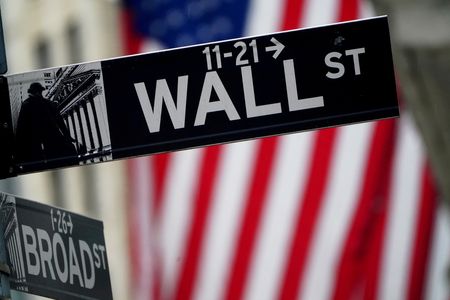LONDON (Reuters) – At an incredible end to the first quarter for financial markets, rattled by bank turmoil, some stability will be much hoped for in coming days.
But don’t bet on it. Regional U.S. banking stocks remain near their lowest levels in two years, Europe is weighing up the fallout from the forced UBS-Credit Suisse tie-up. And data will show how much the market ructions are making recession more likely.
Here’s a look at the week ahead in markets from Kevin Buckland in Tokyo, Lewis Krauskopf in New York and Naomi Rovnick, Amanda Cooper and Dhara Ranasinghe in London.
1/ A COCO-NUTS QUARTER
What a quarter. January saw the biggest rush into equities for the first month of the year on record as investors loaded up on cheap stocks. With “peak rates” essentially priced in, bond yields at multi-year highs suddenly looked juicy. The threat of inflation looked less severe and growth more robust. Crisis averted!
Fast-forward a few weeks and a slew of crypto-companies have folded, U.S. regional banks stocks have tanked in the wake of Silicon Valley Bank collapse and 167-year old Credit Suisse has imploded – and the writedown of some of its contingent convertible bonds (CoCos) has whipped market volatility into a 2008-style frenzy.
“Peak rates” is coming faster than many expected, not because inflation has been vanquished, but because central banks are wary of fanning the flames of a credit crunch, right as the banking sector wobbles.
GRAPHIC: Asset performance – Q3 2023- https://www.reuters.com/graphics/GLOBAL-MARKETS/mopakwdwnpa/chart.png
2/ DON’T BANK ON IT
The collapse of Silicon Valley Bank, a 90% share price drop over two weeks in beleaguered First Republic Bank and a shotgun marriage between Credit Suisse and UBS to avert a wider crisis: banks have gone on a wild ride.
The turmoil may not be over yet. Shares of Germany’s largest bank Deutsche Bank plunged on Friday while wider indicators of financial market stress were also flashing.
SNB chief Thomas Jordan reckons the next two weeks will be vital to securing UBS’s Credit Suisse takeover. Fed Chair Jerome Powell said banking stress could trigger a credit crunch with “significant” implications for a slowing U.S. economy.
And even as central banks and governments step in to stem signs of panic, there’s a new challenge to grapple with – a social media-driven bank run that can be hard to control once rumour and fear take hold.
As Citigroup chief executive Jane Fraser puts it, social media is a “complete game-changer” in bank runs.
Meanwhile, Swiss financial regulator FINMA said it was considering whether to take disciplinary action against Credit Suisse managers.
GRAPHIC: Over $95 billion in market value wiped out in 2 weeks- https://www.reuters.com/graphics/GLOBAL-BANKS/USA/myvmobkeovr/graphic.jpg
3/ DID YOU SAY AT1?
Credit Suisse’s forced takeover by UBS involved $17 billion of Additional Tier 1 debt, shock absorbers if a bank’s capital levels fall below a threshold, being wiped out.
Prices of banks’ AT1s bonds tumbled following the news. Hong Kong, Singapore, the European Union and Britain stepped into to calm the unease.
Potential legal action is also possible after Swiss authorities ruled that holders of Credit Suisse AT1 bonds would get nothing in the deal. Shareholders, who usually rank below debt investors when a company becomes insolvent, will receive $3.23 billion.
Lawyers are assessing whether there is a case against the Swiss authorities. How this plays out in coming days will be watched closely.
The saga has also rocked the $275 billion AT1 bond market, as investors scrutinise debt prospectuses for clauses that could cast doubt over recovery prospects.
GRAPHIC: CoCo crisis- https://www.reuters.com/graphics/GLOBAL-MARKETS/zjpqjnokxvx/chart.png
4/ DATA DIVE
U.S. data that will give insight into the health of the consumer and the state of inflation is timely for investors trying to weigh up whether the economy can stave off a downturn.
The banking crisis has prompted fears that lending will slow, grinding the gears of the economy.
March’s reading of consumer confidence is due on Tuesday. The index unexpectedly fell in February.
On Friday, the February personal consumption expenditure index will offer another look at inflation. It accelerated in January, feeding fears about a more hawkish Federal Reserve.
The Fed raised rates by another quarter point on Wednesday, but recast its outlook from a hawkish preoccupation with inflation to a more cautious stance, given market turmoil that has tightened financial conditions.
GRAPHIC: Powell’s balancing act Powell’s balancing act- https://www.reuters.com/graphics/USA-PCE/T5/mopakwwgbpa/chart.png
5/ INFLATION WATCH
Incoming Bank of Japan Governor Kazuo Ueda will be watching latest Tokyo inflation data closely.
After all, Ueda has the weight of his predecessor’s decade of massive stimulus on his shoulders when he takes over in April.
Expectations are high that he will mastermind a delicate unwinding of yield curve controls and negative interest rates during his tenure, but a key question is when.
Ueda is in no rush, but pressure is building.
The release of Tokyo CPI for March on March 31 is likely to show inflation has topped the BOJ’s 2% target for a 10th straight month. And wage inflation shows signs of catching up.
But policymakers say the economic recovery remains fragile. And U.S. and European banks turmoil show how quickly a crisis can surface, giving Ueda even more reason for caution.
GRAPHIC: Tokyo CPI tops BOJ target for the 11th month- https://www.reuters.com/graphics/JAPAN-ECONOMY/INFLATION/gdpzqknjbvw/chart.png
(Graphics by Prinz Magtulis, Vincent Flasseur, Riddhima Talwani; Compiled by Dhara Ranasinghe; Editing by Bradley Perrett)

